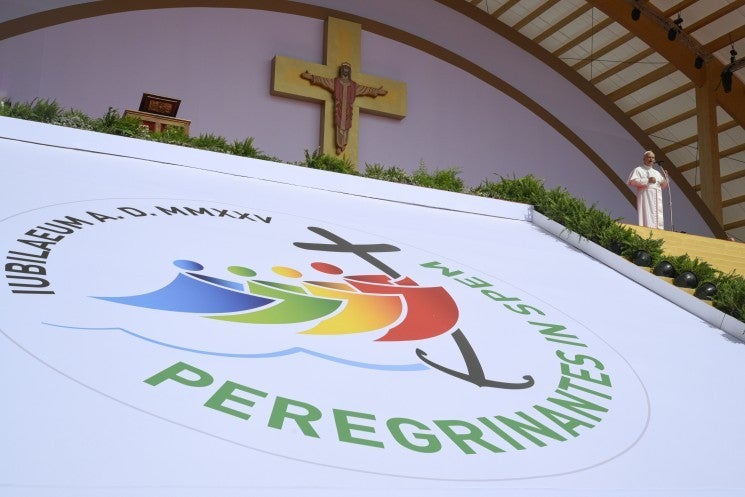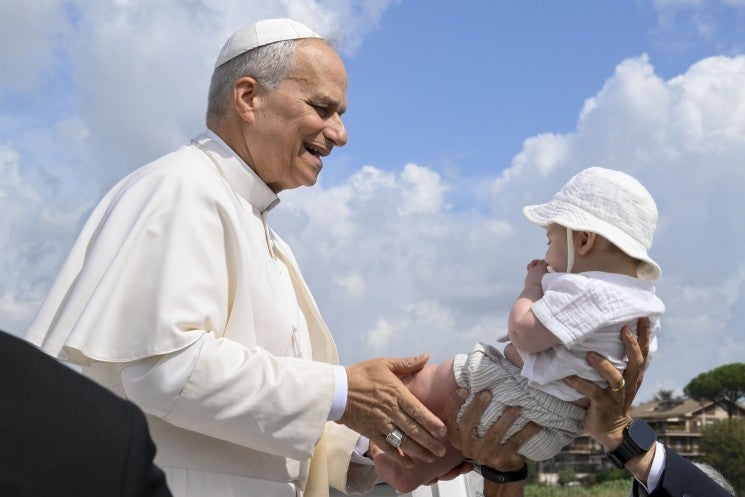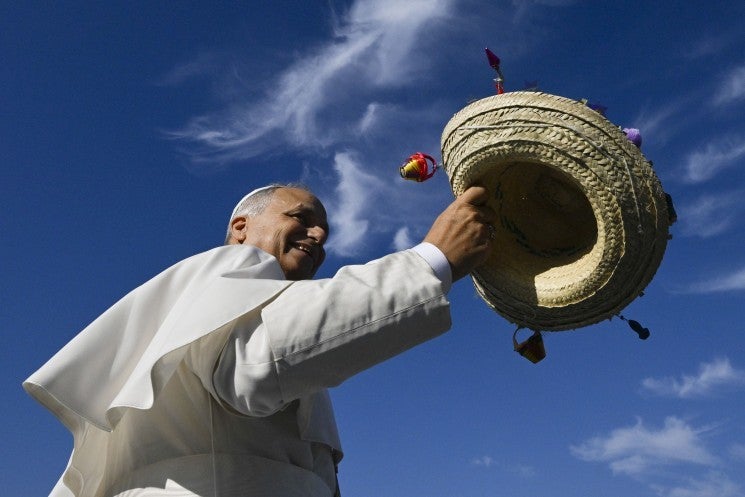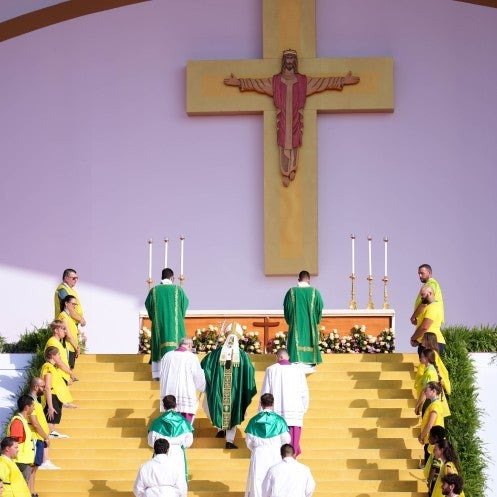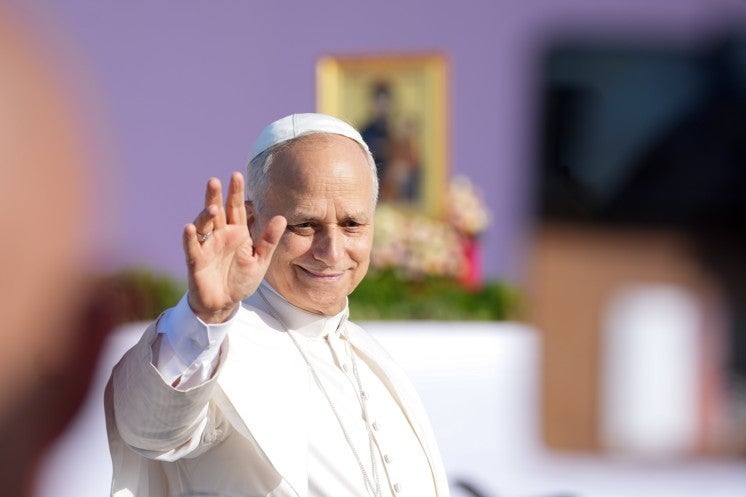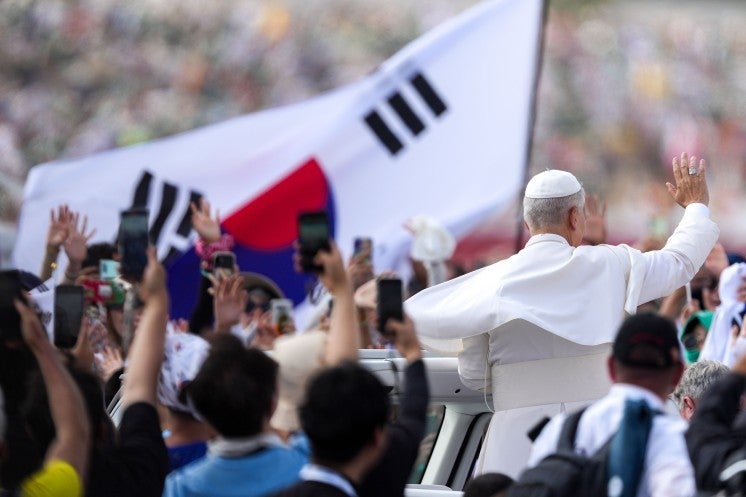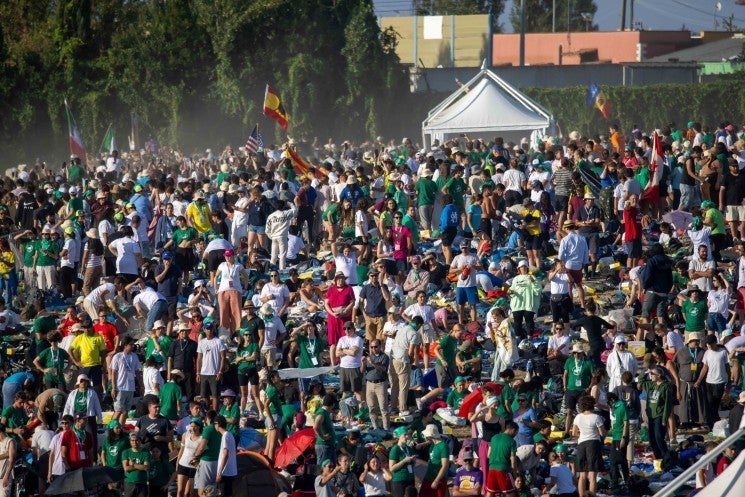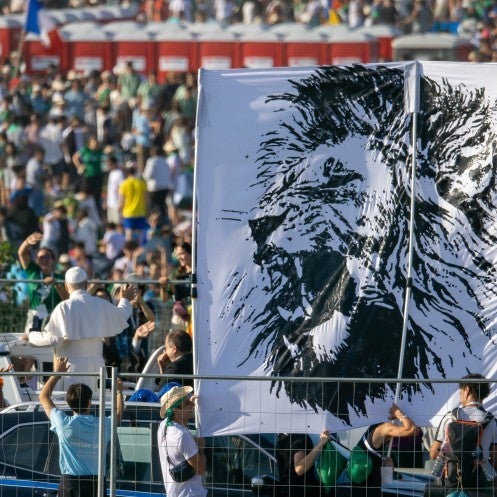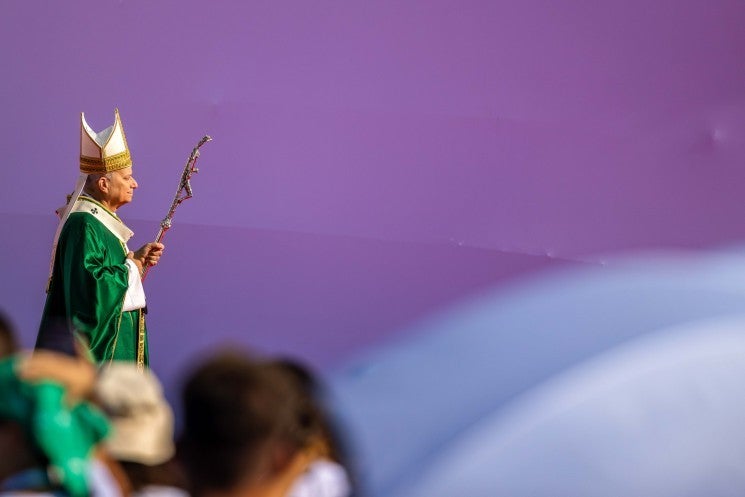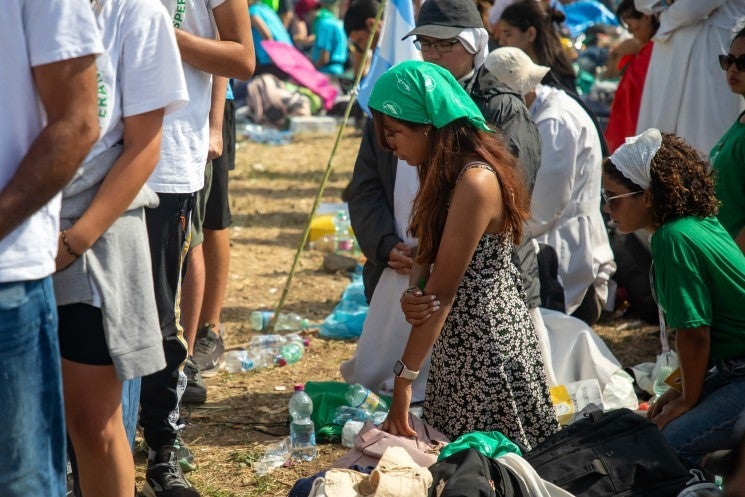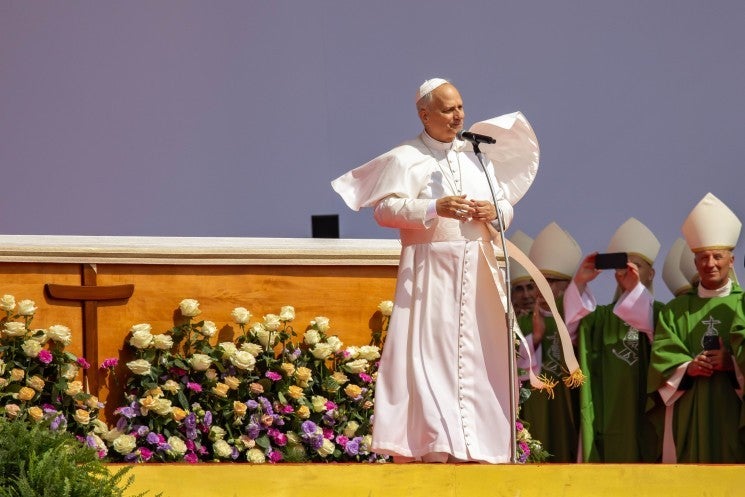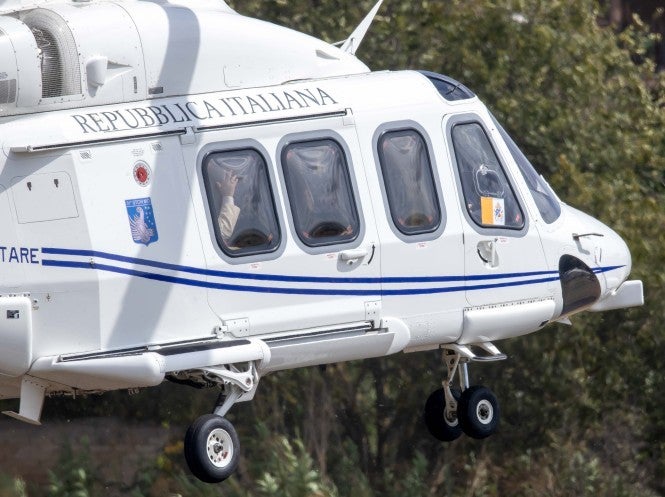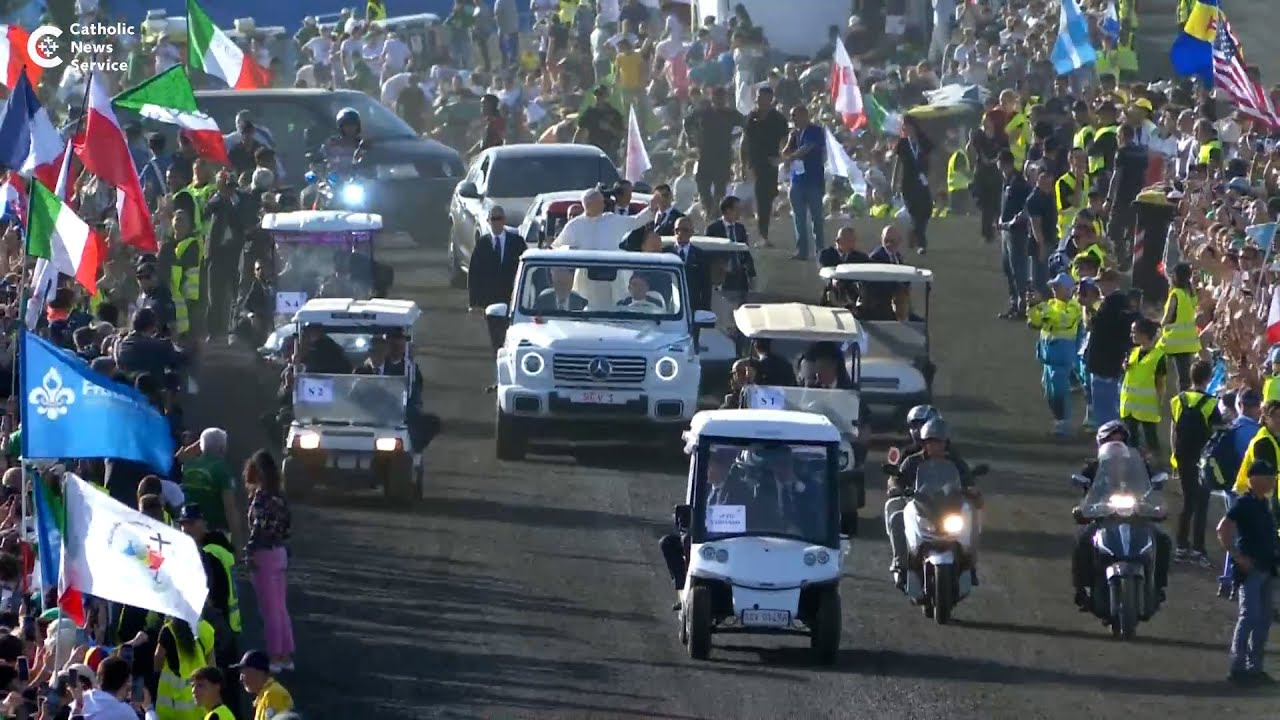Browsing News Entries
Shroud of Turin center disputes new study that challenges authenticity of burial cloth
Posted on 08/5/2025 15:54 PM (CNA Daily News)
 Shroud of Turin featuring positive (left) and negative (right) digital filters. / Credit: Dianelos Georgoudis via Wikimedia Commons
Shroud of Turin featuring positive (left) and negative (right) digital filters. / Credit: Dianelos Georgoudis via Wikimedia Commons
CNA Staff, Aug 5, 2025 / 11:54 am (CNA).
The guardians of the famed Shroud of Turin are disputing the results of a recent study that purports to disprove the cloth’s origins as the burial shroud of Jesus Christ.
Cicero Moraes, a Brazilian 3D artist, claimed in the scholarly journal Archaeometry last month that the depiction of Christ’s body on the shroud was likely made by a “low-relief model” such as a statue rather than a human body.
The imagery on the shroud is “more consistent with an artistic low-relief representation than with the direct imprint of a real human body, supporting hypotheses of its origin as a medieval work of art,” the study alleges.
‘No novelty in this conclusion’
In an Aug. 4 press release, the International Center of Sindonology — the Turin-based organization that leads studies of the Shroud of Turin and promotes its status as a venerated object of Christian devotion — said the nominally new findings of the study were actually considered and disputed more than a century ago.
Moraes’ research “confirms a result known since the early studies [in 1902], whereby the image on the shroud is configured as an orthogonal projection,” the center said. “There is nothing new in this conclusion of the article.”
Investigations by the Shroud of Turin Research Project beginning in the 1970s, meanwhile, ruled out “the formation of the image by means of painting, [rubbing] with bas-relief, or contact with a heated statue/bas-relief.”
The center argued that researchers have known for more than 100 years of the so-called “Agamemnon Mask effect,” a phenomenon in which an imprinted image is distorted when wrapped around a 3D subject.
The researchers argued that the digital modeling software used to create Moraes’ projection of the shroud “is not specifically designed for scientific purposes.” The model’s simulated physics and lack of a support plane, they said, “does not correspond to a real physical context.”
Turin archbishop Cardinal Roberto Repole, who serves as the pontifical custodian of the shroud, said his office has “no reason to comment on hypotheses freely formulated by scientists of varying degrees of credibility.”

The prelate pointed to “concern about the superficiality of certain conclusions” regarding the shroud, “which often do not stand up to closer examination of the work presented.”
In its press release, meanwhile, the center quoted famed theoretical physicist Richard Feynman, who in the early 1970s urged researchers: “If you’re doing an experiment, you should report everything that you think might make it invalid — not only what you think is right about it.”
“The first principle is that you must not fool yourself — and you are the easiest person to fool,” the center said in quoting the scientist.
PHOTOS: White rose petals fall from ceiling of Rome basilica to mark fourth-century miracle
Posted on 08/5/2025 15:23 PM (CNA Daily News)
 A gentle cascade of white rose petals falls from the ceiling of the Basilica of St. Mary Major on Aug. 5, 2025, the feast of the dedication of the basilica, evoking “the miracle of the snow” said to have taken place nearly 17 centuries ago. / Credit: Daniel Ibañez/CNA
A gentle cascade of white rose petals falls from the ceiling of the Basilica of St. Mary Major on Aug. 5, 2025, the feast of the dedication of the basilica, evoking “the miracle of the snow” said to have taken place nearly 17 centuries ago. / Credit: Daniel Ibañez/CNA
Vatican City, Aug 5, 2025 / 11:23 am (CNA).
White rose petals drifted from the gilded ceiling of St. Mary Major Basilica on Tuesday as Romans celebrated the 1,667th anniversary of a fourth-century Marian miracle that inspired the construction of the oldest Marian sanctuary in the West.
According to tradition, the miracle involved a miraculous snowfall in Rome on Aug. 5 in the year 358. The Virgin Mary appeared to both a wealthy Roman nobleman named John and to Pope Liberius (352–366) in a dream foretelling the August snow and asking for a church to be built in her honor on the site of the snowfall.

The basilica was rebuilt by Pope Sixtus III (432–440) after the Council of Ephesus in 431 declared Mary to be the mother of God.
Lithuanian Cardinal Rolandas Makrickas, 53, archpriest of the Basilica of St. Mary Major, celebrated the Mass on Aug. 5 to mark the anniversary of the dedication of the Marian basilica.
Appointed to reorganize the basilica’s administration in 2023 as a coadjutor archpriest, Makrickas officially succeeded Cardinal Stanislaw Rylko, 80, last month.

As the choir sang the “Gloria” during the liturgy, a gentle cascade of white rose petals fell from the basilica’s ceiling, evoking “the miracle of the snow” said to have taken place nearly 17 centuries ago.
In his homily, the cardinal noted that the snowfall “can be understood as a symbol of grace.”

“It can only be received as a gift,” he said. “Grace also arouses admiration and amazement.”
Makrickas noted that Pope Francis participated in last year’s commemoration on Aug. 5. “Pope Francis, who rests in this basilica to be watched over, inspired, and comforted [by] our heavenly mother, Salus Populi Romani, deeply experienced this maternal guidance of Mary,” he said, referring to the revered Marian icon housed in the basilica.

“Like him, thousands of pilgrims, in this jubilee year, walk through the Holy Door of this Marian sanctuary to ask for God’s grace to be able, with renewed faith and a burning heart like the snow, to be witnesses of the great works of God in the world,” he added.
Among the four major papal basilicas in Rome, St. Mary Major is the only one that maintained its original structure. Mosaics dating back to the fifth century can be seen in the central nave of the basilica, which also houses the relic of the Holy Crib from the birth of Christ.

“Dear brothers and sisters, crossing the Holy Door of this basilica means entrusting one’s journey of life and faith to the maternal protection of Mary,” Makrickas said. “And to be inspired by hope is to open oneself to this hope that does not disappoint.”
Father Chris Riley dies at 70: Australian priest founded youth homeless ministry
Posted on 08/5/2025 14:50 PM (CNA Daily News)
 For decades, Father Chris Riley transformed thousands of lives through his Youth Off The Streets project in Australia. He died Aug. 1, 2025, at age 70 after a prolonged illness. / Credit: El Pics/ Getty Images
For decades, Father Chris Riley transformed thousands of lives through his Youth Off The Streets project in Australia. He died Aug. 1, 2025, at age 70 after a prolonged illness. / Credit: El Pics/ Getty Images
CNA Newsroom, Aug 5, 2025 / 10:50 am (CNA).
Australians are paying tribute to a prominent priest who passionately cared for vulnerable young people. For decades, Father Chris Riley transformed thousands of lives through his Youth Off The Streets project. He died Aug. 1 at age 70 after a prolonged illness.
Australian Prime Minister Anthony Albanese led national tributes to the Salesian father in a statement posted on X.
“Father Chris Riley had a heart as big as the country he served. He gave hope to young people doing it tough and never gave up on anyone. He was a good friend and his legacy will live on in the lives he changed,” the prime minister said.
Christopher Keith Riley was born Nov. 24, 1954, in rural Victoria and ordained as a Salesian priest in 1982 after growing up on a dairy farm, The Catholic Weekly reported.
His life’s work began in 1991 when he established Youth Off The Streets with a single food van serving homeless youth in Sydney’s inner-city Kings Cross area.
Under Riley’s leadership for nearly three decades, the effort expanded from its modest beginnings into a comprehensive organization employing over 220 staff and operating more than 30 programs across New South Wales (NSW) and Queensland.
The organization now serves approximately 1,600 homeless youth annually, according to a media release from Youth Off The Streets.
NSW Premier Chris Minns in a statement expressed profound sadness at Riley’s death, describing him as a visionary whose work proved “that with compassion and opportunity, young lives can be transformed.”
Minns noted how the Salesian transformed “a single food van in Kings Cross into a lifesaving network of crisis accommodation, counseling, and other wraparound support services.”
NSW Opposition Leader Mark Speakman (Liberal Party) praised Riley as “a quiet giant” who provided “tens of thousands of young people a sanctuary and a second chance,” CathNews reported.
The bipartisan recognition reflects Riley’s widespread respect across Australia’s political spectrum.
Anne Fitzgerald, chairperson of Youth Off The Streets’ board, remembered Riley as “a tireless advocate for homeless and disadvantaged youth” who “inspired and changed thousands of young lives.”
She emphasized the priest’s “compassion, tenacity, and unwavering belief that every young person deserves the chance to reach their full potential.”
Australian society recognized the Catholic priest’s work with multiple honors: The government appointed him a member of the Order of Australia in 2006 for service to disadvantaged youth. That same year, the Human Rights and Equal Opportunity Commission awarded him the Human Rights Medal.
Riley stepped down from active leadership in 2022 as his health declined but remained connected to the organization he founded. His death marks the end of an era for youth services in Australia, though his organization continues the work he began more than three decades ago.
Judy Barraclough, current CEO of Youth Off The Streets, in the organization’s statement said Riley’s “dedication to supporting and empowering young Australians in need has left a powerful legacy.”
His “vision, drive, and determination will continue to inspire our organization,” she added.
Spanish court rules in favor of Church in eviction lawsuit against schismatic nuns
Posted on 08/5/2025 11:00 AM (CNA Daily News)
 Entrance to St. Clare’s Monastery in Belorado, Burgos, Spain. / Credit: Nicolás de Cárdenas/EWTN News
Entrance to St. Clare’s Monastery in Belorado, Burgos, Spain. / Credit: Nicolás de Cárdenas/EWTN News
ACI Prensa Staff, Aug 5, 2025 / 07:00 am (CNA).
A Spanish court has ruled in favor of the Catholic Church in the eviction lawsuit against the former Poor Clare nuns of Belorado, ordering them to leave the monastery they are illegally occupying.
“The ruling upholds in its entirety the eviction lawsuit filed on Sept. 16, 2024, by the pontifical commissioner as major superior, administrator, and legal representative of the monastery of Belorado,” announced the statement from the office of the pontifical commissioner published Aug. 1.
The papal commissioner, Archbishop Mario Iceta, is also the archbishop of Burgos, where the monastery is located.
The text specifies that the ruling declares “that the eviction of the defendant [the schismatic former nuns] from the aforementioned property is warranted, the possession of which must be returned to the plaintiff, and orders the defendant to vacate, leave the aforementioned property free and clear, and at the disposal of the plaintiff, with the threat of eviction if they do not do so voluntarily.”
The ruling of the lower court, located in the town of Briviesca, follows the July 29 trial and states that “the defendant has not demonstrated, as was their responsibility, that it possesses any title that would justify and legitimize the use of the property” against the demand to vacate by the actual title holder, “which must lead to the full upholding of the claim.”
The ruling also emphasizes that the schismatic former nuns cannot acquire the property they occupy because it is merely “a gathering of individuals [as opposed to a juridical person] lacking the authority” to do so.
Carlos Azcona of the office of the pontifical commissioner said regarding the case that “it is important to note that this ruling addresses the substance of the matter,” stating that the former nuns’ “so-called conventual chapter” is nothing more than “a gathering of individuals lacking the authority to meet as such a chapter.”
He thus noted that “the agreement reached [by the schismatic nuns] regarding the transformation of the monastery into a civil association would be null and void and cannot serve as a justification for the right to continue occupying the monastery.”
Finally, Azcona clarified that “the ruling we learned of yesterday orders the eviction of the schismatic former nuns who do not belong to the monastic community. The older sisters [still in communion with Rome] are the only ones who constitute the Belorado monastic community, and at this time we should not make any statements regarding any action related to them.”
In a previous ruling, the Briviesca court had already set Sept. 12 as the date for the eviction.
The schismatic former nuns of Belorado
The former Poor Clare nuns of Belorado were excommunicated from the Catholic Church for the crime of schism in June 2024 after announcing in May 2024 that they were leaving the Catholic Church and placing themselves under the tutelage of a false excommunicated bishop.
On May 13, when they announced their departure from the Catholic Church, the nuns indicated in a letter and a declaration that they recognize “H.H. Pius XII as the last valid supreme pontiff,” a decision that was explained through an attached 70-page text titled “Catholic Manifesto” claiming that “the see of St. Peter is vacant and usurped.”
At the time, the nuns stated that their community “is leaving the conciliar Church to which it belonged to become part of the Catholic Church.” They complained that in recent years there have been “contradictions, double and confusing language, ambiguity, and loopholes in clear doctrine have been coming from the chair of Peter.”
In addition to the penalty of excommunication, the 10 former nuns were expelled from consecrated life, which meant they were supposed to leave the monastery. However, they did not do so and began a legal battle to remain in the building.
In mid-September 2024, Iceta, the pontifical commissioner appointed by Pope Francis, filed a lawsuit demanding that the schismatic former nuns leave the monastery. He had repeatedly stated that the former Poor Clares could no longer occupy the monastery, having expressed their decision not to remain in the Catholic Church.
This story was first published by ACI Prensa, CNA’s Spanish-language news partner. It has been translated and adapted by CNA
Report: Trump administration may walk back IVF insurance mandate plan
Posted on 08/5/2025 10:00 AM (CNA Daily News)
 null / Credit: Rohane Hamilton/Shutterstock
null / Credit: Rohane Hamilton/Shutterstock
Washington, D.C. Newsroom, Aug 5, 2025 / 06:00 am (CNA).
President Donald Trump’s administration may be walking back an earlier plan that would have required insurance companies to provide coverage for in vitro fertilization (IVF), according to a report from the Washington Post.
The Post reported that “two people with knowledge of internal discussions” told the outlet that the White House does not plan to impose any IVF mandates on health insurance providers.
According to the report, a senior administration official said expanding IVF access is still “a huge priority” for the president but that any government-imposed mandatory coverage would need to come from legislation passed through Congress. The article reported that such a plan is not on the table at the moment.
CNA reached out to the White House for a response to that report and to ask whether religious liberty concerns for Catholics and others opposed to IVF are being weighed in the deliberations but did not get a response by the time of publication.
The Catholic Church opposes IVF because it separates the creation of life from the marital act and because the process results in the destruction of millions of human embryos, which ends human lives. The Southern Baptist Convention officially expressed opposition to IVF last year as well, but many Protestant denominations do not take a formal stance.
Trump first promised nearly a year ago during a campaign rally that the government would either subsidize IVF costs with taxpayer money or impose a coverage mandate on insurers. In October, Trump told EWTN’s Raymond Arroyo that a religious exemption for those opposed to IVF “sounds to me like a pretty good idea” and that “we will look at that.”
As president in February, Trump signed an executive order directing the United States Domestic Policy Council to examine ways to expand IVF access, which sparked immediate concerns from the pro-life community and the United States Conference of Catholic Bishops (USCCB). At this point, the administration has not imposed any rules related to IVF coverage.
Father Thomas Ferguson, who serves on the religious leadership advisory board for Trump’s Religious Liberty Commission, told CNA the report suggesting a departure from an insurance coverage mandate is “welcome news” but that Catholics “must continue to remain vigilant” in opposition to IVF.
IVF, Ferguson said, is “an illicit medical procedure” and must not be portrayed as an “essential health benefit.”
“It is a matter of grave concern that there might exist the possibility that tax dollars would be used to pay for IVF procedures under federally funded insurance plans,” Ferguson said.
“An even more serious concern would be the prospect of the federal government attempting to mandate privately funded insurance plans to pay for IVF services in a manner that would be clearly contrary to the religious beliefs of individuals, business owners, or even churches themselves,” he added.
The Religious Liberty Commission has held one hearing so far, but concerns about potential IVF expansion were not on the agenda. Ferguson said that education will be the focus of the second hearing scheduled for Sept. 8. No other topics have been scheduled yet, but he said he expects Catholic leaders to raise the IVF issue within the context of the commission’s work.
“Catholic belief and teaching that IVF is a morally illicit means of conceiving human life is well known, so it should be no surprise that Catholic leaders and the Catholic faithful would be dismayed by the administration’s commitment to promote IVF as a part of its policy on marriage and family life,” Ferguson added.
Father Tadeusz Pacholczyk, a senior ethicist at the National Catholic Bioethics Center (NCBC), expressed optimism about the report, telling CNA that Trump’s advisers “thankfully seem to have gotten his ear and reminded him that the government ought not be subsidizing IVF in any manner.”
IVF, he said, is “an unethical approach to satisfying parental desires and customer yearnings by erecting and subsidizing an enormous industry to replace what parents themselves are meant to do uniquely within the marital embrace. Human life is not respected in the process but is instead commodified and objectified.”
Rather than covering IVF, Pacholczyk said health insurance should cover “authentic therapies and treatments for infertility,” such as natural procreative technology and Fertility Education and Medical Management, which are pro-life alternatives that seek to address the root causes of fertility struggles.
NCBC past president and senior fellow Joseph Meaney told CNA the report is “highly welcome news” and noted that IVF is “extremely unethical and costly,” while the many pro-life alternatives are “ethically and financially” preferable.
He said the Church has consistently condemned IVF as immoral since 1987 in the document Donum Vitae and that the First Amendment would require that any potential insurance mandate have religious liberty exemptions.
“Religious freedom constitutional guarantees in the U.S. would make it illegal to impose IVF on Catholics and particularly on Catholic employers who might have been required to pay for IVF through their employee health insurance plans,” Meaney added.
Tuesday of the Eighteenth Week in Ordinary Time
Posted on 08/5/2025 08:30 AM (USCCB Daily Readings)
Reading I Numbers 12:1-13
Miriam and Aaron spoke against Moses on the pretext
of the marriage he had contracted with a Cushite woman.
They complained, “Is it through Moses alone that the LORD speaks?
Does he not speak through us also?”
And the LORD heard this.
Now, Moses himself was by far the meekest man on the face of the earth.
So at once the LORD said to Moses and Aaron and Miriam,
“Come out, you three, to the meeting tent.”
And the three of them went.
Then the LORD came down in the column of cloud,
and standing at the entrance of the tent,
called Aaron and Miriam.
When both came forward, he said,
“Now listen to the words of the LORD:
Should there be a prophet among you,
in visions will I reveal myself to him,
in dreams will I speak to him;
not so with my servant Moses!
Throughout my house he bears my trust:
face to face I speak to him;
plainly and not in riddles.
The presence of the LORD he beholds.
Why, then, did you not fear to speak against my servant Moses?”
So angry was the LORD against them that when he departed,
and the cloud withdrew from the tent,
there was Miriam, a snow-white leper!
When Aaron turned and saw her a leper, he said to Moses,
“Ah, my lord! Please do not charge us with the sin
that we have foolishly committed!
Let her not thus be like the stillborn babe
that comes forth from its mother’s womb
with its flesh half consumed.”
Then Moses cried to the LORD, “Please, not this! Pray, heal her!”
Responsorial Psalm Psalm 51:3-4, 5-6ab, 6cd-7, 12-13
R. (see 3a) Be merciful, O Lord, for we have sinned.
Have mercy on me, O God, in your goodness;
in the greatness of your compassion wipe out my offense.
Thoroughly wash me from my guilt
and of my sin cleanse me.
R. Be merciful, O Lord, for we have sinned.
For I acknowledge my offense;
and my sin is before me always:
“Against you only have I sinned;
and done what is evil in your sight.”
R. Be merciful, O Lord, for we have sinned.
That you may be justified in your sentence,
vindicated when you condemn.
Indeed, in guilt was I born,
and in sin my mother conceived me.
R. Be merciful, O Lord, for we have sinned.
A clean heart create for me, O God,
and a steadfast spirit renew within me.
Cast me not off from your presence,
and your Holy Spirit take not from me.
R. Be merciful, O Lord, for we have sinned.
Alleluia John 1:49b
R. Alleluia, alleluia.
Rabbi, you are the Son of God;
you are the King of Israel.
R. Alleluia, alleluia.
Gospel Matthew 14:22-36
Jesus made the disciples get into a boat
and precede him to the other side of the sea,
while he dismissed the crowds.
After doing so, he went up on the mountain by himself to pray.
When it was evening he was there alone.
Meanwhile the boat, already a few miles offshore,
was being tossed about by the waves, for the wind was against it.
During the fourth watch of the night,
he came toward them, walking on the sea.
When the disciples saw him walking on the sea they were terrified.
“It is a ghost,” they said, and they cried out in fear.
At once Jesus spoke to them, “Take courage, it is I; do not be afraid.”
Peter said to him in reply,
“Lord, if it is you, command me to come to you on the water.”
He said, “Come.”
Peter got out of the boat and began to walk on the water toward Jesus.
But when he saw how strong the wind was he became frightened;
and, beginning to sink, he cried out, “Lord, save me!”
Immediately Jesus stretched out his hand and caught him,
and said to him, “O you of little faith, why did you doubt?”
After they got into the boat, the wind died down.
Those who were in the boat did him homage, saying,
“Truly, you are the Son of God.”
After making the crossing, they came to land at Gennesaret.
When the men of that place recognized him,
they sent word to all the surrounding country.
People brought to him all those who were sick
and begged him that they might touch only the tassel on his cloak,
and as many as touched it were healed.
The following text may be substituted,
especially in Year A when the above Gospel is read on Monday:
Some Pharisees and scribes came to Jesus from Jerusalem and said,
“Why do your disciples break the tradition of the elders?
They do not wash their hands when they eat a meal.”
He summoned the crowd and said to them, “Hear and understand.
It is not what enters one’s mouth that defiles the man;
but what comes out of the mouth is what defiles one.”
Then his disciples approached and said to him,
“Do you know that the Pharisees took offense
when they heard what you said?”
He said in reply, “Every plant that my heavenly Father has not planted
will be uprooted.
Let them alone; they are blind guides of the blind.
If a blind man leads a blind man,
both will fall into a pit.”
Lectionary for Mass for Use in the Dioceses of the United States, second typical edition, Copyright © 2001, 1998, 1997, 1986, 1970 Confraternity of Christian Doctrine; Psalm refrain © 1968, 1981, 1997, International Committee on English in the Liturgy, Inc. All rights reserved. Neither this work nor any part of it may be reproduced, distributed, performed or displayed in any medium, including electronic or digital, without permission in writing from the copyright owner.
Veterans Deserve Care and Support, not Abortion, say U.S. Bishops’ President and Pro-Life Chairman
Posted on 08/5/2025 08:30 AM (USCCB News Releases)
WASHINGTON – “The women and men who served our country, to defend innocent life, deserve quality health care and supportive resources, not the violence of abortion,“ said Archbishop Timothy P. Broglio, president of the U.S. Conference of Catholic Bishops (USCCB), and Bishop Daniel E. Thomas, chairman of the USCCB’s Committee on Pro-Life Activities, in response to a proposed rule published by the U.S. Department of Veterans Affairs (VA) on Monday.
In 2022, the VA and dependents’ civilian health benefits were changed to include abortion. The proposed rule would restore the prior, long-standing policy that prevented VA and civilian dependents’ health benefits from including abortion.
“The women and men who served our country, to defend innocent life, deserve quality health care and supportive resources, not the violence of abortion. Veterans’ health facilities must not be places of death, but places of great hope. We are grateful that the Department of Veterans Affairs is stepping up to protect preborn children and families once again from taxpayer-funded, elective abortion, and look forward to reviewing the new proposed rule in full.”
###
Journey together, seek real encounters, pope advises young people
Posted on 08/5/2025 08:30 AM (USCCB News Releases)
VATICAN CITY (CNS) -- A solo traveler, even using Google maps and ChatGPT, cannot safely and happily complete the journey of life or the journey of faith, Pope Leo XIV told thousands of young pilgrims meeting at the Marian shrine in Medjugorje, Bosnia-Herzegovina.
"No algorithm will ever replace a hug, a look, a real encounter -- not with God, not with our friends, not with our family," the pope wrote to people attending the international youth festival known as Mladifest Aug. 4-8.
Pope Leo urged young people to "seek genuine encounters" following the example of Mary, who "undertook a difficult journey to visit her cousin Elizabeth."
The gathering in Medjugorje was the 36th annual youth festival and the first to be held after the Vatican Dicastery for the Doctrine of the Faith published a notification in September 2024 recognizing the spiritual value of devotions connected to Medjugorje but not ruling on the authenticity of the alleged apparitions there or alleged messages from Mary.
Six young people, aged 10 to 16, said Mary began appearing to them in June 1981. Three of them say they still have apparitions of Mary each day, while the other three have them only on special occasions.
Pope Leo did not mention the apparitions or the Vatican notification in his message, instead focusing on the theme of the gathering, "Let us go to the house of the Lord."
"This phrase speaks to us of a journey, of a desire that moves us toward God, toward the place of his dwelling, where we can truly feel at home, because his love awaits us there," the pope wrote.
"On the road of life, we never walk alone," he told the young people. "Our journey is always intertwined with that of others: we are made for encounter, for walking together and for discovering a shared destination."
Young or old, he said, Christians "are not solitary pilgrims. The path toward the Lord is traveled together. That is the beauty of faith lived in the church."
Traveling to Bosnia-Herzegovina from dozens of countries, the pilgrims also discover that "there is a language stronger than any barrier -- the language of faith, nourished by the love of God."
"You are all members of his body, which is the church," the pope wrote, encouraging the young people to "meet one another, get to know one another, share with one another."
And, he said, "if any of you feels within yourselves the call to a special vocation -- to consecrated life or to the priesthood -- I encourage you not to be afraid to respond. That invitation, which you feel stirring within you, comes from God, who speaks to our hearts. Listen to him with trust: the word of the Lord not only makes us truly free and happy but leads to our fulfillment as people and as Christians."
Don't settle for less; God is waiting to transform your life, pope tells youth
Posted on 08/4/2025 08:30 AM (USCCB News Releases)
ROME (CNS) -- The fullness of life depends on how much one joyfully welcomes and shares in life while also living with a constant yearning for those things that only come from God, Pope Leo XIV told young people.
"Aspire to great things, to holiness, wherever you are. Do not settle for less. You will then see the light of the Gospel growing every day, in you and around you," he said in his homily during Mass concluding the Jubilee of Youth Aug. 3.
The outdoor Mass, held in Rome's Tor Vergata neighborhood on the outskirts of the city, marked the culmination of a week-long series of events for the Jubilee of Youth.
More than 1 million people were estimated to be gathered across the 130 acres that had been prepared for the morning Mass, the prayer vigil the evening before, and for the hundreds of thousands of people sleeping overnight.
After touching down by helicopter less than 12 hours after leaving the evening vigil, the pope rode in the popemobile throughout the open areas -- dotted with tents and tarps, and filled with young people, cheering, waving their nation's flag, and sometimes launching at him shirts and gifts.
"Good morning!" he said in six languages from the massive stage set up for the Mass.
"I hope you all rested a little bit," he said in English. "We will shortly begin the greatest celebration that Christ left us: his very presence in the Eucharist."
He said he hoped the concluding Mass would be "a truly memorable occasion for each and every one of us" because "when together, as Christ's church, we follow, we walk together, we live with Jesus Christ."
In his homily during the Mass, the pope again highlighted the importance of the Eucharist, as "the sacrament of the Lord's total gift of himself to us."
It is Christ, the Risen One, he said, "who transforms our lives and enlightens our affections, desires and thoughts."
"We are not made for a life where everything is taken for granted and static, but for an existence that is constantly renewed through the gift of self in love," he said.
Much like a field of flowers, where each small, delicate stem may dry out, become bent and crushed, he said, each flower is "immediately replaced by others that sprout up after them, generously nourished and fertilized by the first ones as they decay on the ground. This is how the field survives: through constant regeneration."
"This is why we continually aspire to something 'more' that no created reality can give us; we feel a deep and burning thirst that no drink in this world can satisfy," he said. "Knowing this, let us not deceive our hearts by trying to satisfy them with cheap imitations!"
Pope Leo urged the young people to listen to that yearning and "turn this thirst into a step stool, like children who stand on tiptoe, in order to peer through the window of encounter with God," who has been "waiting for us, knocking gently on the window of our soul."
"It is truly beautiful, especially at a young age, to open wide your hearts, to allow him to enter, and to set out on this adventure with him towards eternity," he said.
Speaking briefly in English, the pope said, "There is a burning question in our hearts, a need for truth that we cannot ignore, which leads us to ask ourselves: what is true happiness? What is the true meaning of life? What can free us from being trapped in meaninglessness, boredom and mediocrity?"
"Buying, hoarding and consuming are not enough," he said. The fullness of existence "has to do with what we joyfully welcome and share."
"We need to lift our eyes, to look upwards, to the 'things that are above,' to realize that everything in the world has meaning only insofar as it serves to unite us to God and to our brothers and sisters in charity, helping us to grow in 'compassion, kindness, humility, meekness and patience,' forgiveness and peace, all in imitation of Christ," he said.
Evoking St. John Paul II's words during the XV World Youth Day prayer vigil held in the same spot 25 years ago, Pope Leo reminded the young people that "Jesus is our hope."
"Let us remain united to him, let us remain in his friendship, always, cultivating it through prayer, adoration, Eucharistic communion, frequent confession, and generous charity, following the examples of Blessed Pier Giorgio Frassati and Blessed Carlo Acutis, who will soon be declared saints," he said.
Wishing everyone "a good trip home," he encouraged the young people to "continue to walk joyfully in the footsteps of the Savior, and spread your enthusiasm and the witness of your faith to everyone you meet!"
Lasting Peace Requires Conversion of Heart and Elimination of Nuclear Weapons, says Archbishop Broglio
Posted on 08/4/2025 08:30 AM (USCCB News Releases)
WASHINGTON - “We must renew our efforts to work for the conversion of heart required for a global commitment to lasting peace, and thus the elimination of nuclear weapons,” said Archbishop Timothy P. Broglio, president of the U.S. Conference of Catholic Bishops, in a message marking the 80th anniversary of the use of atomic weapons on the people of Hiroshima and Nagasaki.
In his message, Archbishop Broglio underscored the importance of prayer and renewed efforts toward universal nuclear disarmament and lasting peace:
“Certainly, the atrocities of war continue to be evident even in our ‘developed world,’ where human life is victimized in the womb, near death, on the streets of our modern cities, and in the various war zones of the contemporary world. We are slow to learn. Longing for peace, we pray for a change in mentality and an ever-deeper respect for every human person. We advocate that dollars be spent in favor of development rather than for arms. We pray that the attitudes and absence of dialogue that led to the use of atomic arms eighty years ago might give way to mutual understanding, peace building, and international cooperation.
“As we mark this doleful anniversary, we recognize the ongoing threat of nuclear weapons and their proliferation. We must renew our efforts to work for the conversion of heart required for a global commitment to lasting peace, and thus the elimination of nuclear weapons. This week, let us prayerfully remember the victims of Hiroshima and Nagasaki, and urge the United States and the international community to work diligently for nuclear disarmament around the world. Following Pope Leo XIV’s recent appeal, we exhort all nations to ‘shape their future by works of peace, not through violence and bloody conflict!’”
###


